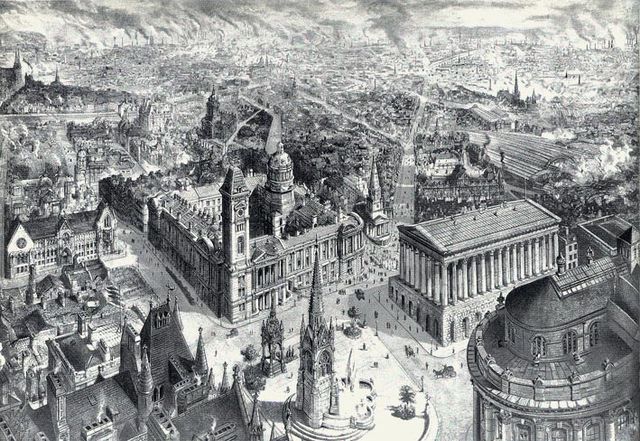The best free self-guided walking tours
Birmingham 1
Chamberlain Square – Power, Politics and Industry
Standing in Chamberlain Square, you’re at the intersection of Birmingham’s industrial might and political reform. The square’s recent renovation masks its deep connections to the city’s manufacturing heritage, but the stories are still there if you know where to look.
The dominant figure here is Joseph Chamberlain, whose statue provides the square’s focal point. Look closely at his pose – he’s depicted mid-speech, reflecting his role as the great industrial reformer. The statue shows typical Victorian confidence, but notice how his famous monocle and orchid buttonhole were carefully carved, humanizing details of a man who transformed Birmingham from a poorly managed industrial town into a model of municipal governance. His hand gestures toward what was once a vista of factory chimneys, now replaced by modern offices.
The square’s distinctive gradient tells an industrial story – it was deliberately leveled to create a plateau above the industrial quarters, allowing the civic buildings to literally look down on the workshops below. This elevation served a practical purpose too, helping to lift Birmingham’s civic heart above the industrial smog that once filled the lower areas.
The newly restored Central Library building maintains the industrial-era practice of using locally sourced materials where possible. But look at the original stonework that remains – you can spot the marks of acid rain damage from Birmingham’s industrial pollution, particularly on the older sections facing Paradise Street. The square’s modern paving pattern subtly references the geometric designs found in Birmingham’s industrial products, from jewelry to metalwork.
Ironically, the square’s contemporary appearance, with its clean lines and open spaces, more closely resembles its original Victorian layout than the cluttered post-war design it replaced. The Victorians wanted an unobstructed space where industrial wealth could be translated into civic pride. Today’s square serves the same purpose, though showcasing different kinds of commerce.
Around the edges, look for the preserved Victorian lampposts, manufactured in local foundries and deliberately oversized to demonstrate Birmingham’s metalworking expertise. The modern lighting cleverly references these original features while incorporating contemporary technology.
The view towards Paradise Street reveals how the square connected to Birmingham’s industrial transport network – the slope leads down towards the canal system that once transported goods to and from the city’s thousands of workshops. This physical connection between civic space and industrial infrastructure was crucial to Birmingham’s success.
Next, we’ll head down to The Roundhouse to see how Birmingham’s industrial heritage is directly connected to its canal network…

